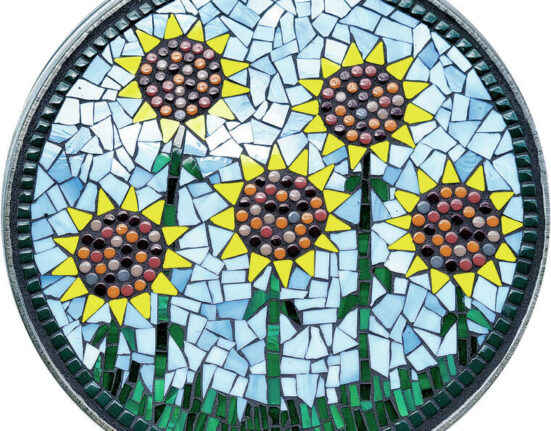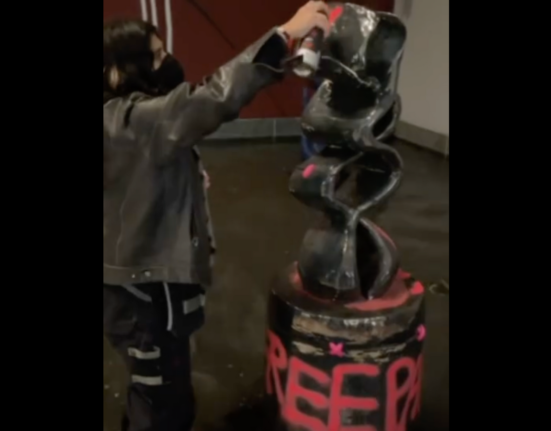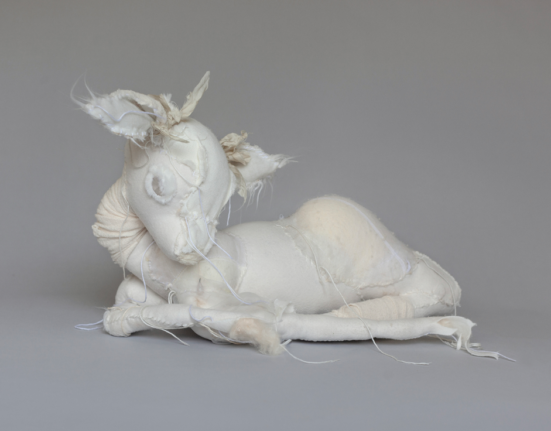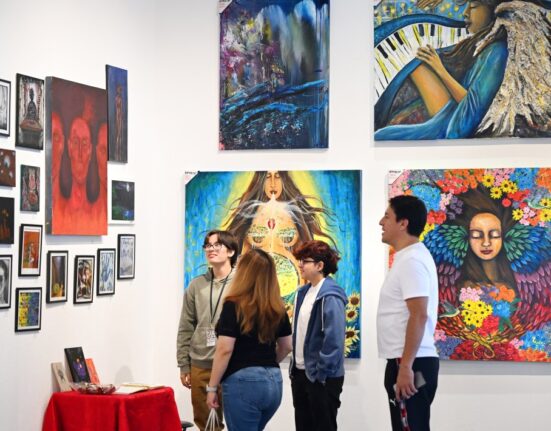Komal Shah is a collector who fully inhabits her advocacy for women artists. To the extent that, as she gave a preview tour of a new exhibition culled from her collection, her colorful coat—seemingly designed to resemble brushstrokes—blended into the works she was describing. Her figure appeared to be embraced by a massive Joan Mitchell abstraction, enveloped in a sweeping Julie Mehretu landscape, and all but indistinguishable from a Cecily Brown painting. She had, effectively, become one with her own exhibition.
“Making Their Mark” (through January 27, 2024) showcases eight decades of artistic output by more than 80 women artists, ranging from 20th-century luminaries like Judy Chicago and Mary Corse to ultra-contemporary artists such as Jenna Gribbon, Jadé Fadojutimi, and Firelei Báez. Every piece hails from Shah’s 300-strong collection, she said, 90 percent of which have come from the hands of women.
Installation view of “Making Their Mark.” Left to right: Tschabalala Self, Sisters (2021), Firelei Báez, For Améthyste and Athénaïre (Exiled Muses Beyond Jean Luc Nancy’s Canon), Anacaonas (2018), Lynette Yiadom-Boakye, Afterword (2019). Courtesy of Komal Shah.
“It’s very important for me to expose my collection to young people,” she said. “I thought this would be a great way to tell the story” of women in art. The exhibition, spread over two floors of the former Dia Chelsea space in New York, marks the first public viewing of the Shah Garg Collection, a body of work envisioned by both Komal and her husband Gaurav Garg, a tech entrepreneur and partner of the venture capital firm Wing. At their home in San Francisco’s Bay Area, these works fill every inch of wall space. “I somehow managed to get it all crammed in there,” Shah laughed. “Well, maybe not the 20-foot paintings.”
To curate the show, Shah invited Cecilia Alemani, curator of the acclaimed 2022 Venice Biennale, which was inspired by Surrealist artist Leonora Carrington‘s book The Milk of Dreams, and shined a light on undersung female artists. The first Italian woman to hold the position, Alemani also serves as the chief curator of High Line Art in New York.
“When Cecilia came to the house months ago,” recalled Shah, “she asked, ‘Is it OK if I take all of these works away? Will your walls be empty?’ I replied, ‘Hmmm, I’m pretty sure I can find a few others to fill in.’”
From the start, abstraction has been at the core of the collection. Shah and her husband would view works together, “Rothko, Kandinsky, we gravitated toward those artworks because they struck a visual chord for us,” she said. “Abstraction is a very unifying force in that it takes away boundaries of gender, race, region. You can tell universal stories.”
Installation view of “Making Their Mark.” Left to right: Miriam Schapiro, Double Rose (1978), Merikokeb Berhanu, Untitled LXXIII (2021), Sonia Gomes, Sol maior (2023), Sonia Gomes, Artérias (série telacorpo) (2022). Courtesy of Komal Shah.
In particular, Shah soon found herself consumed with women abstractionists. She remembered the moment clearly. “It was 2014,” she said, “and I went to the Whitney Biennial with Mark Godfrey, a mentor of mine who used to be a curator at Tate.” She paused for the extra impact. “I came across works by Jacqueline Humphries and Laura Owens, and my heart raced. I didn’t even know the artists yet, but I responded to their work to the point of literally falling in love.”
She then asked Godfrey how she should make sense of this new-to-her group of artists, especially what their relationship to each other was. “Mark literally drew a whole network of how these artists are interconnected, a network of influence,” said Shah. “It has been very, very useful to someone who studied computer science and not art history.”
She proved a quick study. “She can go into a show of new works by an artist and identify the strongest object,” emailed Godfrey, now an independent curator. “Putting aside all her advocacy for work by women, and her understanding that ‘women artists’ do not constitute a monolithic group, Komal has a basic passion for art and artists, and excellent taste. Her goal is to collect works by unfairly ignored women artists, and also of justly celebrated women artists.”
Charline von Heyl, Plato’s Pharmacy (2015). Courtesy of Komal Shah.
“After I started getting to know Jacqueline Humphries, Amy Sillman, Charline von Heyl, Laura Owens, and Rachel Harrison, I realized that there was this group of amazing artists who were almost all coexisting,” said Shah.
She also got an education in gender inequity in the art world, how differently male and female artists have been treated. She then embarked on a kind of conversation tour in an attempt to get to the root of the imbalance, beginning with Kymberly Pinder, president of the Yale School of Art. “We’ve talked at length about how the numbers are even in art programs, with women sometimes outnumbering men. Then, somehow, as they begin their careers, women start disappearing. There’s a huge drop-off between school and getting accepted to a gallery.”
Shah, who sits on the board of the Haas School of Business at UC Berkeley, said she’s seen an “alarming progression” where women graduates in all majors make 85 cents for every dollar that men earn, yet 10 years later that figure drops to 60 cents. Shah attributes the decrease to women leaving the workforce and having to start over if they re-enter it. Even more alarming, she explained that research done by art historian Dr. Helen Gorrill, which found that women graduates who take up careers in art earn a tenth of what men do. “I’ve never seen such an egregious disparity,” she said.
Installation view of “Making Their Mark.” Left to right: Mary Corse, Untitled (White Grid, Horizontal Strokes) (1969), Lynda Benglis, Baby Planet (1969), Lenore Tawney, Inquisition (1961), Pat Stier, For Philadelphia Three (2013). Courtesy of Komal Shah.
Shah—who rose to senior positions at Oracle, Netscape, and Yahoo after moving to the U.S. from India to attend Stanford—has no qualms about diving into statistics. She further cited an Artnet investigation in 2019 that revealed only 12 percent of works that museums acquired between 2008 and 2018 were made by women. “I can actually see this happening,” she said. “I’ve been on acquisition committees for a variety of museums.”T
“There’s a lot of bias going on in the art world around gender,” Shah realized, adding, “if I was going to be spending a lot of time, passion, and money that it had to be about a cause. I want to make a difference.”
Recently Shah’s collecting has expanded to include craft and fiber artists, after discussions with Katy Siegel, author and art professor at Stony Brook University. Like Mark Godfrey, Shah considers Siegel a mentor, calling her “my North Star who brings all the hidden voices to the front.”
Emma Amos, Star (1982). Courtesy of Komal Shah.
Through those discussions, Shah realized that “the gatekeepers of what gets defined as fine art have been men, and textiles and craft were never part of that.” She called attention to an abstract work near the exhibition’s entrance created by Janet Sobel, widely considered to be the first artist of drip paintings. She showed at Peggy Guggenheim’s gallery in 1945, alongside Louise Bourgeois and Kay Sage. The art critic Clement Greenberg attended the show and called Sobel’s work “housewife trash,” said Shah, “and basically destroyed her career. Then Jackson Pollock came up with his own drip paintings a few years later and Clement Greenberg, as we know, was a champion.”
In response to this “skewed” scenario, Shah sought to elevate ‘housewife’ art by bringing textiles and fiber into the collection, coexisting with sculpture and painting, “as well as ceramics to a lesser degree,” said Shah. But “it’s only been about three or four years so I’m still expanding there.”
Installation view of “Making Their Mark.” Left to right: Françoise Grossen, Contact III (1977), Elizabeth Murray, Joanne in the Canyon (1990-91). Courtesy of Komal Shah.
Siegel remembers those conversations well. “I think it’s interesting,” she said by email, “that Komal began by insisting on a place at the big table of modern art for women artists working in large-scale abstraction, women who were clearly excellent as measured by criteria determined by men, but simply not seen. As she has continued to look and think, Komal has increasingly championed a wide variety of art by women, including art that does not measure itself in those terms.”
“Some of [our] original conversations about decoration and women’s work,” added Siegel, “have developed into explorations of ways of making—textiles and ceramics—that have often been denigrated or dismissed. [We’re] looking at artists like Toshiko Takaezu, Trude Guermonprez, Joyce Scott, and Marie Watt, seeing that their art is absolutely as thoughtful, masterful, and creative as any painting or sculpture.”
Shah has also, of late, been harboring “a love for women artists over 70, especially over 80,” artists like Lynda Benglis, Kay WalkingStick, Mary Heilmann, and Olga de Amaral. “If I see a great artist in that genre, that tells me they’ve persisted and endured, which is of critical importance for me. I think the collection has a lot of strength in that area.”
Shah’s advocacy for women-forward art has progressed to the point where she no longer thinks of herself as a collector, but rather a custodian. “This collection is not about a small group of people; it represents 51 percent of the population,” she said. “The collection has a purpose, which is to tell stories, to make the community and the public aware. I think that is my legacy.”
“Making Their Mark” is on view at 548 West 22nd Street through January 27, 2024, after which it will travel to the Berkeley Art Museum at the University of California, Berkeley, followed by the Kemper Art Museum at Washington University in St. Louis. The exhibition is free and open to the public.
Follow Artnet News on Facebook:
Want to stay ahead of the art world? Subscribe to our newsletter to get the breaking news, eye-opening interviews, and incisive critical takes that drive the conversation forward.







